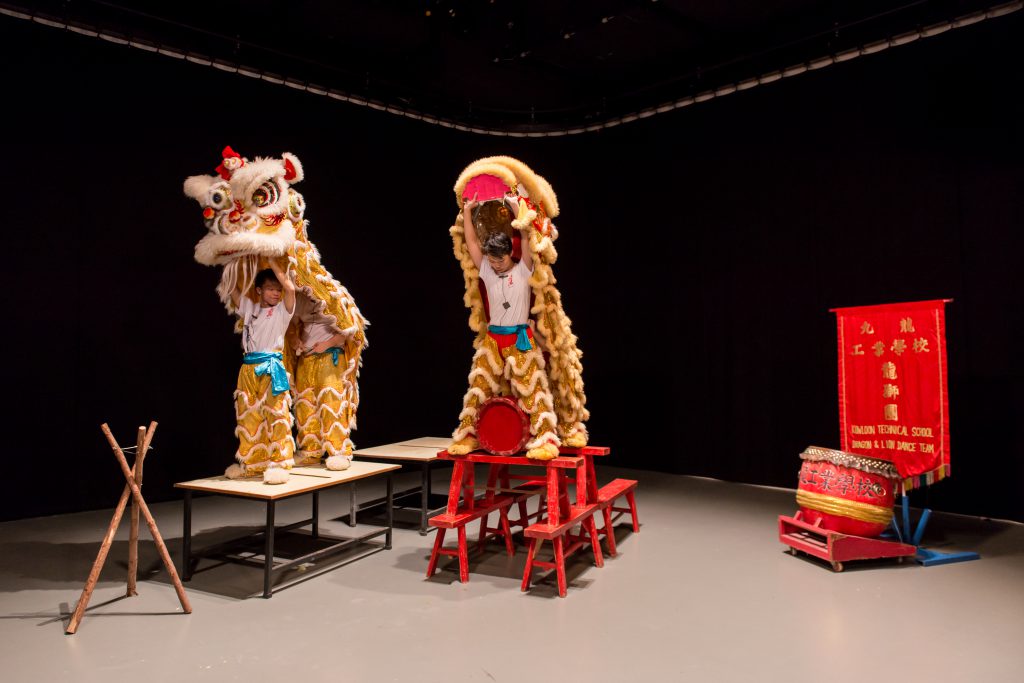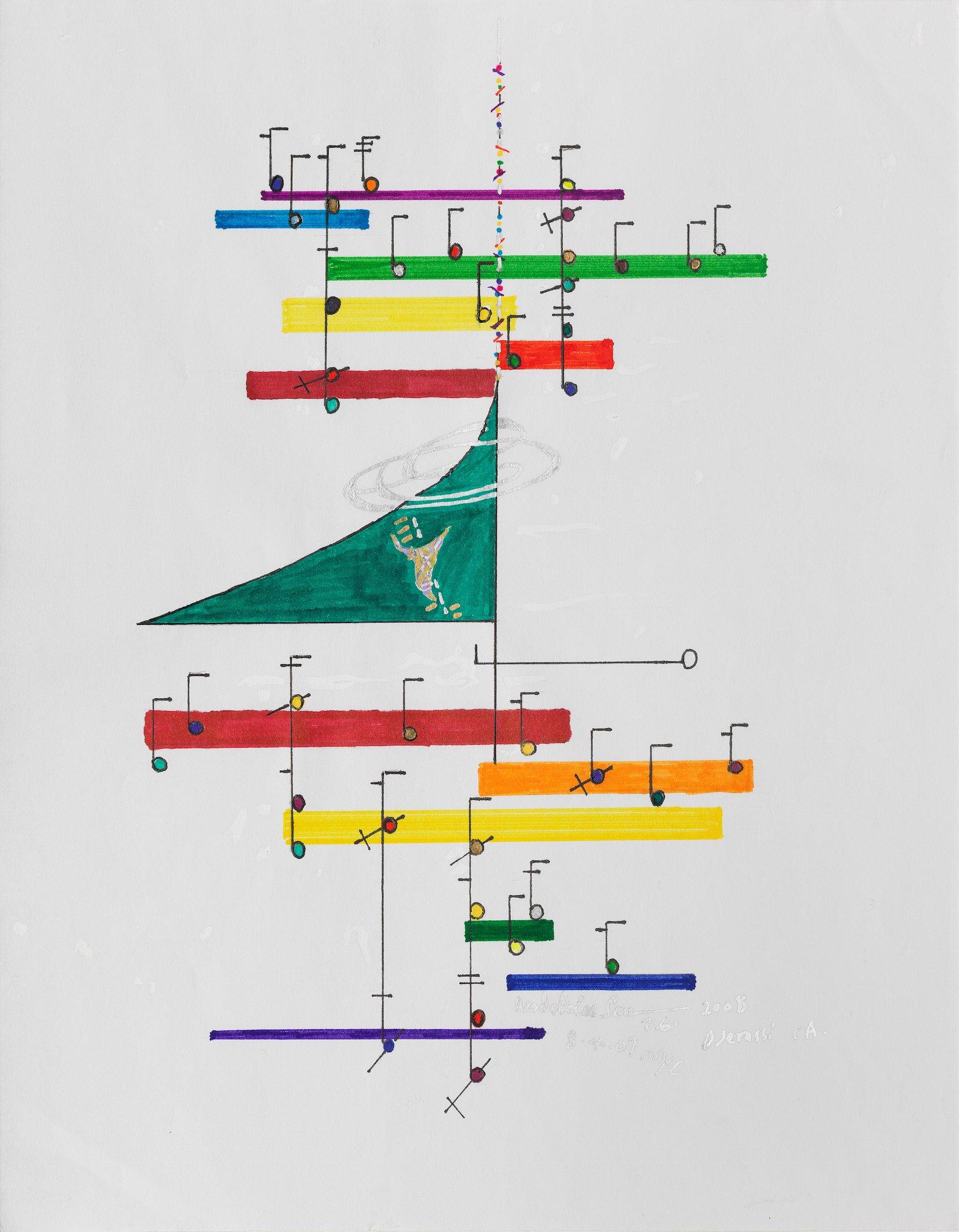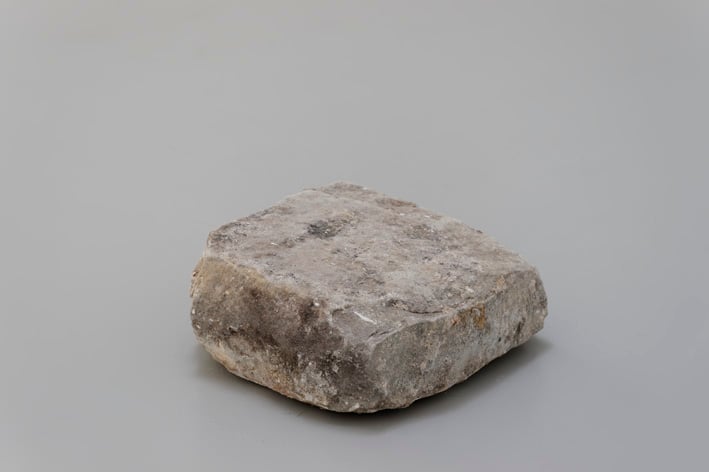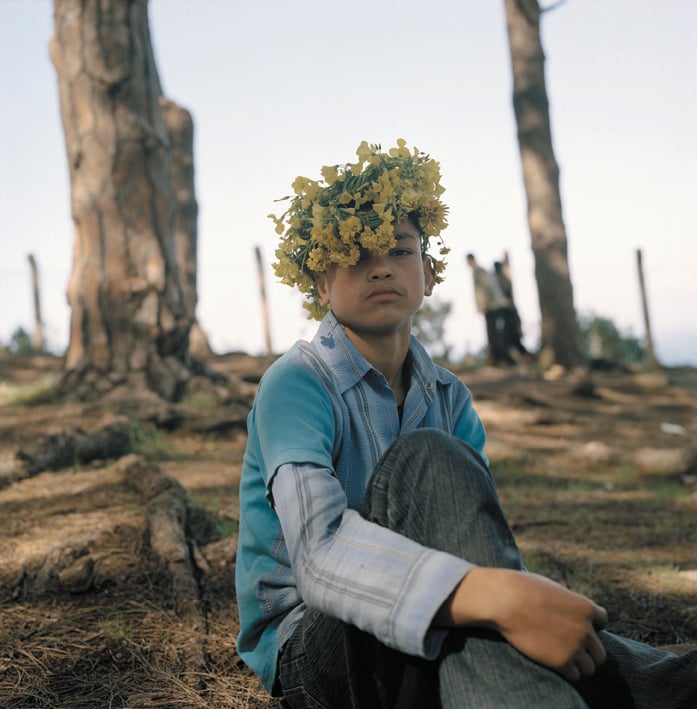
© » KADIST
Jorge González
Easy to fold and carry, Jorge González’s Banquetas Chéveres (Chéveres Stools) embody the nomadic and flexible nature of the Escuela de Oficios. González’s work employs a modernist language while paying homage to artisanal techniques specific to Puerto Rico and the Indigenous knowledge, people, and histories of the Carribean. Reinterpreting the furniture line ArKlu (1945-1948) conceived by the architects Stephen Arneson and Henry Klumb, the stools were conceived in collaboration with various artisans in Puerto Rico–Eustaquio Alers, a weaver from Aguadilla, Joe Hernández from Ciales, and MAOF from San Juan, a contemporary wood-salvaging collective, among others.
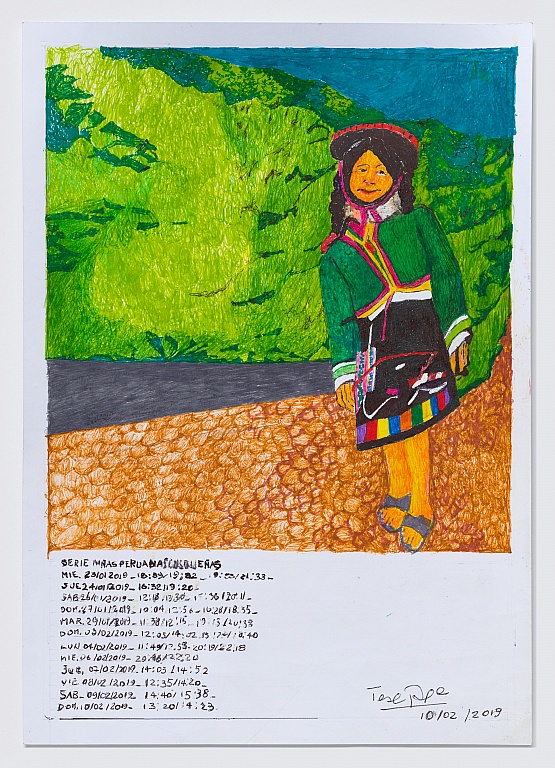
© » KADIST
Teresa Burga
Drawing & Print (Drawing & Print)
In her new series titled Ninas Peruanas Cusquenas , Teresa Burga depicts young indigenous women from Peru’s Andean region, dressed in traditional garments. Sourcing imagery from the internet, the drawings recall an untitled series of drawings from 1974, in which Burga selected images of women at random from various print media, and then rendered the images on paper. Those drawings, like the newer ones, suggest the perils of images without context––how assumptions are made, stereotypes are formed, and knowledge is gathered.

© » KADIST
Amor Muñoz
Yuca_tech: Energy by Hand is an installation by Amor Muñoz that resulted from a local technology lab in a small village in the Yucatán henequen zone, in the Mayan region of Mexico. The lab was designed as a community technology space that focuses on developing forms of production through collaboration rather than through capitalist means of production based on private ownership and driven by financial profits. More specifically, the workshop and activities of the lab merge Indigenous crafting techniques with open-source technologies and solar energy to create technology-based artworks.

© » KADIST
Matthew Lutz-Kinoy
The Lion’s Hunt by Matthew Lutz-Kinoy is a large format painting that recalls Delacroix’s paintings and tapestries from the 19th century, where the painterly surface became a garden invaded by wild beasts. In Lutz-Kinoy’s painting, two ferocious lions appear to be preying on several horses. Accentuated by luminous browns and yellows, the lions evoke imperialist fantasies.

© » KADIST
Katia Kameli
Katia Kameli’s film The Storyteller explores the cultural role of deep-rooted artistic tradition in Morocco. Marrakech’s largest public square is well known for its al-halqa , a storyteller’s circle or circle of spectators. Abderrahim Al Azalia is a hlaïqya; it is his role to animate the al-halqa.

© » KADIST
James Webb
Referencing psychology, philosophy, and spiritualism, A series of personal questions addressed to a Hikimawashi kappa traveling coat by James Webb is an ongoing series in which the artist poses spoken questions to objects via a speaker installed near the object on display. The questions are addressed to the objects as if they were sentient beings able to respond. Each question is left hanging, unanswered for approximately 10 seconds before the next question is posed.

© » KADIST
Samson Young
In Muted Situations #2: Muted Lion Dance by Samson Young, Chinese lion dancers perform the auspicious procession traditionally presented at special occasions such as weddings or during the Lunar New Year. Yet, the customary percussive sound of drums and cymbals are absent. Instead, it is the sound of the performers’ physical exertion that comes to the forefront, revealing the beautiful, exhaustive rhythm of their craft—their feet hitting the ground, deep inhales and exhales, and the rustling of their clothes.

© » KADIST
Farah Al Qasimi
Farah Al Qasimi’s approach to photography deviates from the norms and conventions of traditional figurative and portrait photography. It’s Not Easy Being Seen 2 is from a series of photographs depicting women who are otherwise unnoticed by the public. In this work, her subject is obscured by a bright, green fabric (also referred to as a morph suit) that uses the concept of green screen technology to conceal identity.

© » KADIST
Angelica Mesiti
Angelica Mesiti’s piece, The Calling (2013-14) is a poignant exploration of ancient human traditions evolving and adapting to the modern world. The three-channel work focuses on traditional whistling languages and shows the communities of the village of Kuskoy in Northern Turkey, the island of La Gomera in the Canary Islands, and the island of Evia, Greece, where such languages are all still in use. For these communities, whistling languages are in a process of transformation from their traditional use as tools for communication across vast lands into tourist attractions and cultural artifacts and are being taught to local school children.

© » KADIST
Brian Tripp
For many years Tripp has been involved in reviving Karuk ceremonies that had been discontinued for decades, he developed his signature abstract style, based in Karuk design, ceremonial regalia forms, and related cultural and political iconography. The two works in the KADIST collection are a continuation of these forms with in the medium of sculpture.

© » KADIST
Amol k Patil
The title of the performance video work Impression by Amol k Patil refers to an Indian tradition. During a Hindu or Muslim weddings, all the inhabitants of the chawl (very modest buildings) cover their chests, arms, and feet with henna. For this work the artist covered his chest with temporary henna tattoos before applying Fervicol, a synthetic resin adhesive.

© » KADIST
Reyes Santiago Rojas
The work Sarta (String) by Reyes Santiago Roja is part of a larger series of works that examine the commercialization of the tobacco plant and its relationship to the meaning and use of tobacco by Native American tribes such as the Mayas, Aztecs, Incas or Tainos, which attributed spiritual qualities to tobacco such as the smoke carrying one’s thoughts and prayers to the sprits. In this work the artist studied the forms of tobacco leaves native to Latin America and recreated their shapes with commercial tobacco packaging from such global brands as Marlboro or Camel to the most popular Colombian brand Pielroja. The leaves made of the packaging material are lined up on a string as if they are hung out to dry as in traditional tobacco making processes.

© » KADIST
Naresh Kumar
Drawing & Print (Drawing & Print)
“Relation between Black and blood” explores the connection between performance, installation and representation. The artist’s use of watercolour is inherited from Mughal miniature painters who migrated from Delhi to the East India Company on the Ganges for the opium trade. The Miniaturists used cheaply available transparent Mica to paint images of the water carrier, the cobbler, dancers, prostitutes, wanderers and god men.

© » KADIST
Ana Roldán
Ana Roldán’s Primeval forms series looks up close at the fecund shapes of plants often found in the artist’s native Mexico. These botanical portraits, like this one of the Pseudobombax ellipticum, or shaving brush tree, bristle against the edges of the image’s frame, fecund and wild, familiar yet foreign. Ana Roldán works in diverse media such as performance, sculpture, installations, video and collage.

© » KADIST
Marguerite Humeau
This work forms part of a project that draws upon research into the use of psychoactive substances present in animal brains during the Paleolithic period. Bolstered by research by archaeologist Bethe Hagens, the artist explores the hypothesis that prehistoric shamans consumed the psychoactive parts of animal brains in order to achieve spiritual ecstasy and that the found figurines, reproduced by Marguerite Humeau, are an archival remnant of these experiences. The so-called “Venus figurines” take the form of ambiguous female forms and despite their exaggerated gendered traits, the onus is instead upon the resemblance to the ingested animal brains that led to their production.

© » KADIST
Nadia Myre
First exhibited as part of the recent multidisciplinary project Code Switching and Other Work , at Art Mûr, Berlin in late 2018, Nadia Myre’s Untitled (Tobacco Barrel) takes inspiration from the cylindrical vessels used to import tobacco from North America to Europe during periods of early colonial settlement. Responding to the history of clay pipe production in the ports of London, Bristol, and Glasgow by weaving together the literal detritus of the colonial tobacco trade, Myre’s work poetically untangles material links between the British Empire, Canada, and Indigenous peoples. Following contact with the so-called New World in the 1600s, the growing popularity of tobacco use in Europe led to the design and widespread manufacturing of disposable, pre-stuffed clay tobacco pipes in Britain.

© » KADIST
Sofía Córdova
dawn chorus ii: el niagara en bicicleta is a work produced in Sofía Córdova native Puerto Rico and was largely shaped by the financial crisis, the islands’ histories under colonial rule and most recently, the climate-change related natural disasters which have affected the island. The latest of which, hurricane Maria, and the subsequent political mishandling of the situation, gave the project its ending. Prior to the hurricane, this work also engaged in conversation with blackness and anti-blackness in the Caribbean, syncretic religion and dance music as modes of survival and liberation, and fantasy and science-fictional strategies as means to break out of our current arc of history.

© » KADIST
Leonor Antunes
Discrepancies with Oaxacan Textile II by Leonor Antunes is a hanging sculpture composed of three elements made of brass. This sculptural work was originally produced for the exhibition Discrepancies with Clara Porset (2018) at Museo Tamayo, which featured reassembled objects from early 20th century Cuban designer Clara Porset. Antunes’s work explores Mexican traditions through a contemporary context.
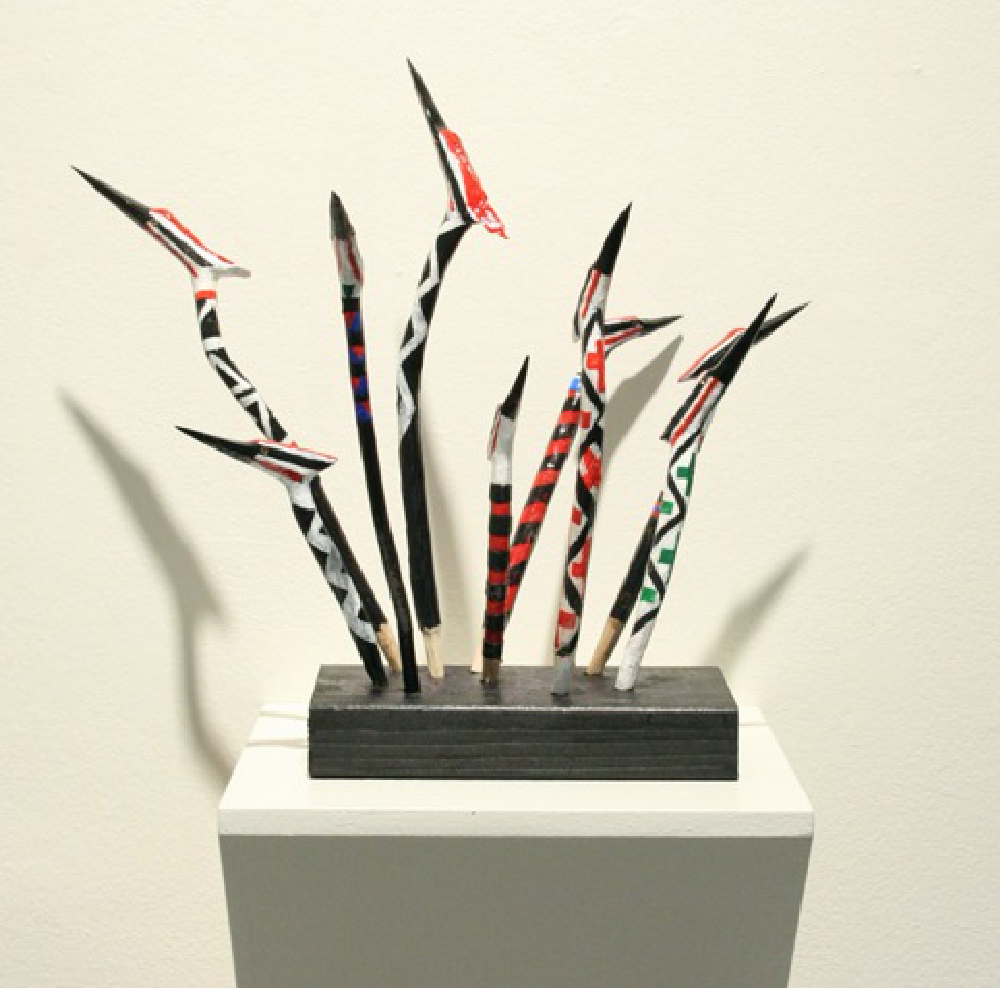
© » KADIST
Brian Tripp
For many years Tripp has been involved in reviving Karuk ceremonies that had been discontinued for decades, he developed his signature abstract style, based in Karuk design, ceremonial regalia forms, and related cultural and political iconography. The two works in the KADIST collection are a continuation of these forms with in the medium of sculpture.
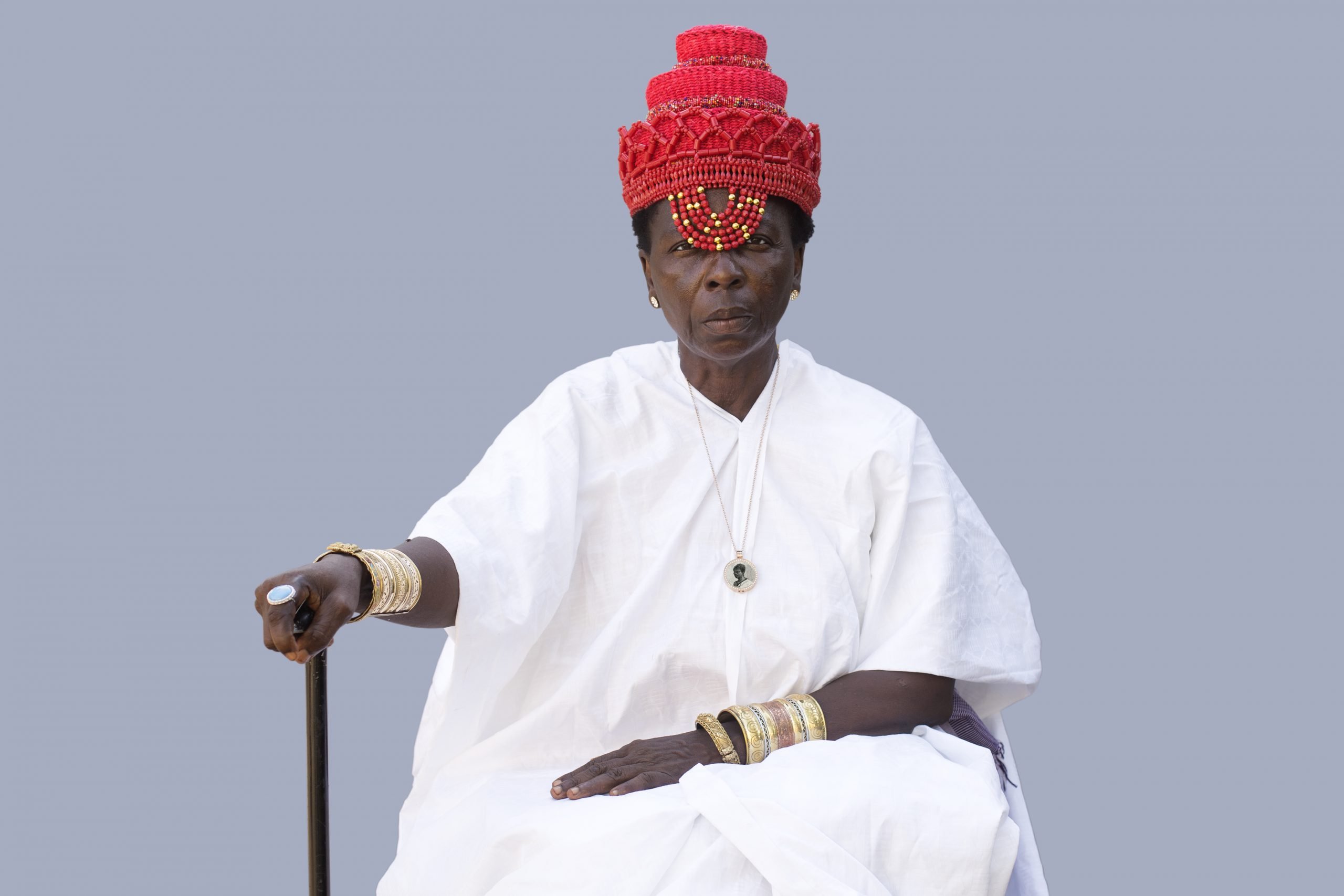
© » KADIST
Ishola Akpo
Noticing the lack of archives on the queens of various African kingdoms, artist Ishola Akpo created several series of work that retrace their history. Akpo uses different mediums in these projects, as a metaphor to the complex stories of the figures and their true political weight. One part of the project, the Agbara Women photographic series, employs fictional portraits that sheds light on the queens’ histories.

© » KADIST
Tanatchai Bandasak
Central Region by Tanatchai Bandasak is a meditation on materiality and time-based media centres on the mysterious, prehistoric ‘standing stones’ of Hintang in Northern Laos: little-studied megaliths which have survived thousands of years of political change and the cataclysmic carpet-bombing of Laos by the United States during the Cold War. In Bandasak’s unpretentious, animist portrait of the ruins, what is remarkable is the absence of the embodied observer, instead, it is the technical parsing of the digital video camera that enlivens these prodigiously still, mute and enduring objects, through a chanceless sequence of static shots, dissolving measure and revealing gradual modulations of light. The piece evokes a spectral landscape energised by the undead and the nonhuman, opening up contemporary philosophical questions via seemingly ageless and inert artifacts.

© » KADIST
Nazgol Ansarinia
In the early 2000s, as urban redevelopment accelerated and intense construction significantly diminished public space in Tehran, state-funded murals began to represent imaginary landscapes on building facades. The municipality of Tehran uses such pictorial representation to to exert influence over and come to terms with the flow of communal desire. The protrusion of the unreal onto the real interrupts the values, independence, and functionality of one over the other.

© » KADIST
Hao Liang
Eight Views of Xiao and Xiang is a series of landscapes in the Xiaoxiang region in the modern day Hunan Province, China, and was a popular subject of poems, drawings and paintings during the Song Dynasty (960–1279). Liang follows tradition by interpreting the historical subjects by classical Chinese artists including Dong Yuan (934–962 AD), Mu Xi (died in 1281 AD), Wen Weiming (1470–1559 AD). This reinterpretation represents the meeting point of the Xiang River and the Dongting Lake.
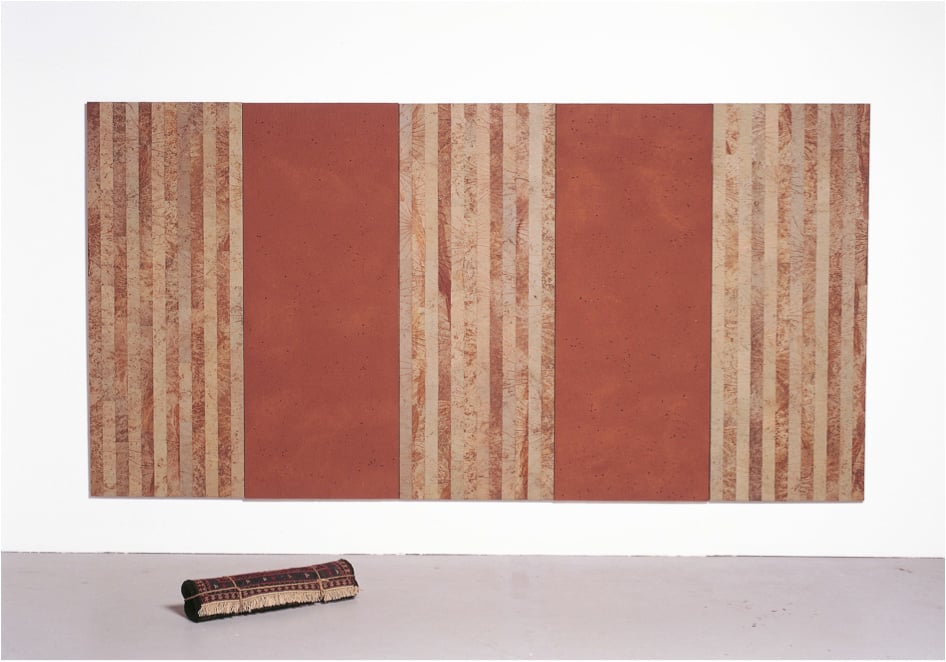
© » KADIST
Hossein Valamanesh
In Runner there are two elements:a big painting and a rolled Persian rug. The rug refers to Iran’s cultural history. The travelling tribes used to transport rugs through the desert on camels or horses so that they would always have a comfortable place to sleep and dream.

© » KADIST
João Maria Gusmão and Pedro Paiva
The artist duo João Maria Gusmão and Pedro Paiva traveled to Japan for a month to make a series of short 16mm films, often shot in slow-motion. This film, shown in continuous loop, has a run-time of just under 3 minutes, and is presented without sound. It captures a traditional Shisa (combination of a dog and lion from Okinawan mythology) animated by an invisible person.

© » KADIST
Taloi Havini
Following her family’s political exile to Australia in 1990, Havini began to document her journey’s home to the north of Buka Island, in the Autonomous Region of Bougainville. Reflecting on the still visible aftermath of conflict and changing economic factors, Havini creates traditional beroana or shell money from extracted earth materials only found on Solomon islands like Bougainville. Havini’s whirling assemblage of ceramic discs emulate the strings of shell money (still valid around the Pacific as system of payments) to examine the economic changes that occurred in her homeland.

© » KADIST
Citra Sasmita
The work Timur Merah Project 2, the harbour of restless spirit is stretched out on a full cow’s hide, replicates the Kamasan Balinese painterly language that Citra Sasmita has developed in her recent works. It represents female figures, flames, and various natural elements, permutating whimsically in a narrative of pansexual energy. While rooted in mythological thinking, with specifically Hindu and Balinese references, the scenes are equally part of a contemporary process of imagining a secular and empowered mythology for a post-patriarchal future.

© » KADIST
Gyempo Wangchuk
The various distinct but connected lineages of Himalayan painting remain thriving languages employed by artists from across the region to express their unique perspective in our shared contemporary world. In Bhutan in particular, this language is prevalent and its maintenance is seen through the political prism of preserving Bhutan’s identity in the global world. That being said, o ffering by Gyempo Wangchuk presented an attempt to bring a critical dimension within the traditional Himalayan forms of expression.

© » KADIST
siren eun young jung
Deferral Archive is one of the archival extensions of siren eun young jung’s Yeoseong Gukgeuk Project (2008-), a decade-long ethnographic research project into the diminishing genre of Korean traditional theater known as Yeoseong Gukgeuk . The genre, which was popular in the 1950s-60s, has since been forgotten, without ever being established as either a traditional or modern form of Korean theater. The most distinctive formal trait of Yeoseong Gukgeuk is that the theater performers are exclusively women.
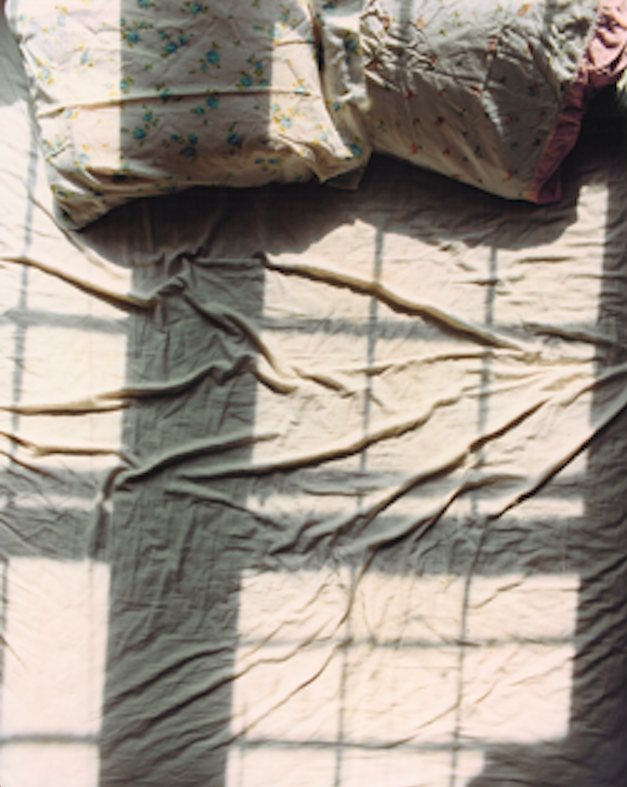
© » KADIST
Tammy Rae Carland
Carland’s series of large-format photographs Lesbian Beds (2002) depicts beds that have been recently vacated. Shot from directly above, they are lavish views of very private spaces. The artist plays to her viewers’ voyeuristic impulses, inviting us to look, but then denying us the opportunity to study the figures to whom the sheets belong, so that the rumpled covers become like anthropomorphic stand-ins inviting empathic projection.
siren eun young jung
With a practice deeply engaged with feminism and LGBT rights issues, siren eun young jung reveals the subversive power of traditional culture, one unknown in the Korean modernization period, and provides unique perspectives and documentation of important communities...
Brian Tripp
Brian D...
Teresa Burga
A pioneer of Latin American Conceptualism, since the 1960s, Teresa Burga has made works that encompass drawing, painting, sculpture, and conceptual structures that support the display of analytical data and experimental methodologies...
Xiaoyun Chen
- location: Hangzhou, China
- year born: 1971
- gender: male
- nationality: Chinese
- home town: Hubei Province, China
Citra Sasmita
Artist Citra Sasmita’s work is inscribed with originality in a pan-Asian effort to revisit traditional artistic languages as tools of expression in contemporary society...
Samson Young
Samson Young is a Hong Kong-based artist whose practice interlays multiple narratives and references with sound and cultural politics at its heart...
Reyes Santiago Rojas
Reyes Santiago Rojas works with themes relates to nature, patience and garbage...
Angelica Mesiti
Splitting her time between Sydney and Paris, Angelica Mesiti is a video, performance, and installation artist of Italian origin...
Naresh Kumar
Naresh Kumar (b...
Taloi Havini
From the Nakas clan, Hakö people, interdisciplinary artist Taloi Havini was raised in Arawa, Autonomous Region of Bougainville...
Tanatchai Bandasak
Artist Tanatchai Bandasak began his career as a filmmaker, however following his studies at art school in France, he began exploring installation and sculptural strategies for presenting moving images...
Nazgol Ansarinia
- location: Tehran, Îran
- year born: 1979
- gender: female
- nationality: Iranian
Farah Al Qasimi
Working primarily with photography, video and performance, Farah Al Qasimi examines postcolonial structures of power, gender, and taste in the Gulf Arab states...
Hossein Valamanesh
Hossein Valamanesh’s work is often made out of natural material or found objects such as Persian rugs, family photo albums or clothes...
Katia Kameli
Katia Kameli is a visual artist and director whose practice is rooted in its research-focused approach...
Mariana Castillo Deball
- location: Amsterdam & Berlin
- year born: 1975
- gender: female
- nationality: Mexican
- home town: Mexico City, Mexico
Yto Barrada
- location: Tangier, Morocco
- year born: 1971
- gender: male
- nationality: French-Moroccan
- home town: Paris, France
Leonor Antunes
Leonor Antunes’s sculptures consider and reinterpret 20th century design, architecture, and modernist art, focusing in particular on work created by women...
Ishola Akpo
Ishola Akpo is a photographer and multimedia artist whose practice explores the possibilities of digital technology...
Amol k Patil
Interested in vernacular theater and performance, Amol k Patil works within family tradition: his grandfather was an interpreter and a poet (Powada Shahir, a troubadour telling epic stories as he went from one village to another), and his father was an avant-garde playwright, who addressed issues, such as the devastating effects of immigration and its traumas through absurd situations in his plays...
Marguerite Humeau
Marguerite Humeau’s work begins with intensive research that calls upon the expertise of various specialists including historians, anthropologists, paleontologists, zoologists, linguists or conspiracy theorists...
Gyempo Wangchuk
Gyempo Wangchuk is a unique artist in the Bhutanese, and wider Himalayan context because he combines his classical training in traditional Bhutanese painting with contemporary concepts and aesthetics, as well as discreet but potent expressions of dissidence...
Matthew Lutz-Kinoy
Matthew Lutz-Kinoy has a multifaceted practice, vacillating from painting to poetry, theater performance to ceramics...
Nadia Myre
The work of Nadia Myre, member of the Kitigan Zibi Anishinabeg First Nation, is notable for its embrace of cross-cultural mediations as a strategy towards celebrating and reclaiming the far-reaching intellectual and aesthetic contributions of Indigenous communities...
Tammy Rae Carland
Using photography, text, and video, Tammy Rae Carland tactically realigns traditional ideas of love, partnership, domesticity, and family...
James Webb
James Webb is a conceptual artist, known for his site-specific interventions and installations...
Hao Liang
The work of Hao Liang reimagines and explores the sublime of contemporary ecological landscapes...
-
1990-1999
-
2000-2009
Tammy Rae Carland
2002Carland’s series of large-format photographs Lesbian Beds (2002) depicts beds that have been recently vacated...
Yto Barrada
2007This photograph is part of the series titled “Iris Tingitana project” (2007) focusing on the disappearance of the iris...
-
2010-2019
Brian Tripp
2010For many years Tripp has been involved in reviving Karuk ceremonies that had been discontinued for decades, he developed his signature abstract style, based in Karuk design, ceremonial regalia forms, and related cultural and political iconography...
Brian Tripp
2010For many years Tripp has been involved in reviving Karuk ceremonies that had been discontinued for decades, he developed his signature abstract style, based in Karuk design, ceremonial regalia forms, and related cultural and political iconography...
Katia Kameli
2012Katia Kameli’s film The Storyteller explores the cultural role of deep-rooted artistic tradition in Morocco...
Amol k Patil
2012The title of the performance video work Impression by Amol k Patil refers to an Indian tradition...
Ana Roldán
2012Ana Roldán’s Primeval forms series looks up close at the fecund shapes of plants often found in the artist’s native Mexico...
Xiaoyun Chen
2012The lengthy titles in Chen Xiaoyun’s work often appear as colophons to his photographs that invite the viewer to a process of self realization through contemplating the distance between word and image...
Angelica Mesiti
2013Angelica Mesiti’s piece, The Calling (2013-14) is a poignant exploration of ancient human traditions evolving and adapting to the modern world...
Nazgol Ansarinia
2013In the early 2000s, as urban redevelopment accelerated and intense construction significantly diminished public space in Tehran, state-funded murals began to represent imaginary landscapes on building facades...
siren eun young jung
2013Deferral Archive is one of the archival extensions of siren eun young jung’s Yeoseong Gukgeuk Project (2008-), a decade-long ethnographic research project into the diminishing genre of Korean traditional theater known as Yeoseong Gukgeuk ...
Amor Muñoz
2014Yuca_tech: Energy by Hand is an installation by Amor Muñoz that resulted from a local technology lab in a small village in the Yucatán henequen zone, in the Mayan region of Mexico...
Samson Young
2014In Muted Situations #2: Muted Lion Dance by Samson Young, Chinese lion dancers perform the auspicious procession traditionally presented at special occasions such as weddings or during the Lunar New Year...
Reyes Santiago Rojas
2015The work Sarta (String) by Reyes Santiago Roja is part of a larger series of works that examine the commercialization of the tobacco plant and its relationship to the meaning and use of tobacco by Native American tribes such as the Mayas, Aztecs, Incas or Tainos, which attributed spiritual qualities to tobacco such as the smoke carrying one’s thoughts and prayers to the sprits...
Naresh Kumar
Drawing & Print
2015(Drawing & Print) “Relation between Black and blood” explores the connection between performance, installation and representation...
João Maria Gusmão and Pedro Paiva
2015The artist duo João Maria Gusmão and Pedro Paiva traveled to Japan for a month to make a series of short 16mm films, often shot in slow-motion...
Taloi Havini
2015Following her family’s political exile to Australia in 1990, Havini began to document her journey’s home to the north of Buka Island, in the Autonomous Region of Bougainville...
siren eun young jung
2015Deferral Archive is one of the archival extensions of siren eun young jung’s Yeoseong Gukgeuk Project (2008-), a decade-long ethnographic research project into the diminishing genre of Korean traditional theater known as Yeoseong Gukgeuk ...
siren eun young jung
Drawing & Print
2015(Drawing & Print) Deferral Archive is one of the archival extensions of siren eun young jung’s Yeoseong Gukgeuk Project (2008-), a decade-long ethnographic research project into the diminishing genre of Korean traditional theater known as Yeoseong Gukgeuk ...
Gyempo Wangchuk
2016The various distinct but connected lineages of Himalayan painting remain thriving languages employed by artists from across the region to express their unique perspective in our shared contemporary world...
Jorge González
2017Easy to fold and carry, Jorge González’s Banquetas Chéveres (Chéveres Stools) embody the nomadic and flexible nature of the Escuela de Oficios...
Farah Al Qasimi
2017Farah Al Qasimi’s approach to photography deviates from the norms and conventions of traditional figurative and portrait photography...
Marguerite Humeau
2018This work forms part of a project that draws upon research into the use of psychoactive substances present in animal brains during the Paleolithic period...
Nadia Myre
2018First exhibited as part of the recent multidisciplinary project Code Switching and Other Work , at Art Mûr, Berlin in late 2018, Nadia Myre’s Untitled (Tobacco Barrel) takes inspiration from the cylindrical vessels used to import tobacco from North America to Europe during periods of early colonial settlement...
Sofía Córdova
2018dawn chorus ii: el niagara en bicicleta is a work produced in Sofía Córdova native Puerto Rico and was largely shaped by the financial crisis, the islands’ histories under colonial rule and most recently, the climate-change related natural disasters which have affected the island...
Leonor Antunes
2018Discrepancies with Oaxacan Textile II by Leonor Antunes is a hanging sculpture composed of three elements made of brass...
Teresa Burga
Drawing & Print
2019(Drawing & Print) In her new series titled Ninas Peruanas Cusquenas , Teresa Burga depicts young indigenous women from Peru’s Andean region, dressed in traditional garments...
Matthew Lutz-Kinoy
2019The Lion’s Hunt by Matthew Lutz-Kinoy is a large format painting that recalls Delacroix’s paintings and tapestries from the 19th century, where the painterly surface became a garden invaded by wild beasts...
Tanatchai Bandasak
2019Central Region by Tanatchai Bandasak is a meditation on materiality and time-based media centres on the mysterious, prehistoric ‘standing stones’ of Hintang in Northern Laos: little-studied megaliths which have survived thousands of years of political change and the cataclysmic carpet-bombing of Laos by the United States during the Cold War...
Citra Sasmita
2019The work Timur Merah Project 2, the harbour of restless spirit is stretched out on a full cow’s hide, replicates the Kamasan Balinese painterly language that Citra Sasmita has developed in her recent works...
-
2020-2029
Ishola Akpo
2021Noticing the lack of archives on the queens of various African kingdoms, artist Ishola Akpo created several series of work that retrace their history...
James Webb
2022Referencing psychology, philosophy, and spiritualism, A series of personal questions addressed to a Hikimawashi kappa traveling coat by James Webb is an ongoing series in which the artist poses spoken questions to objects via a speaker installed near the object on display...







